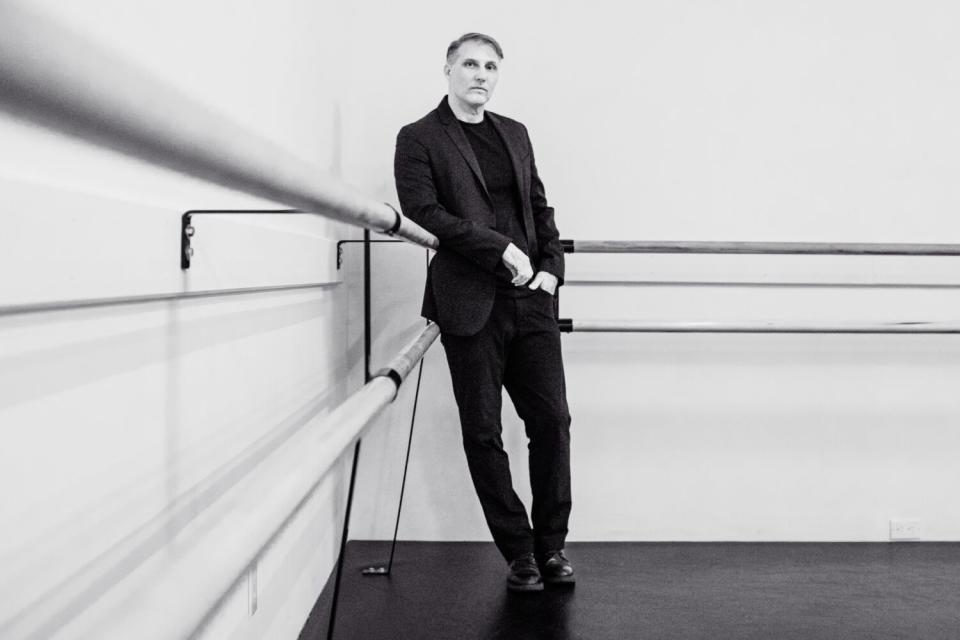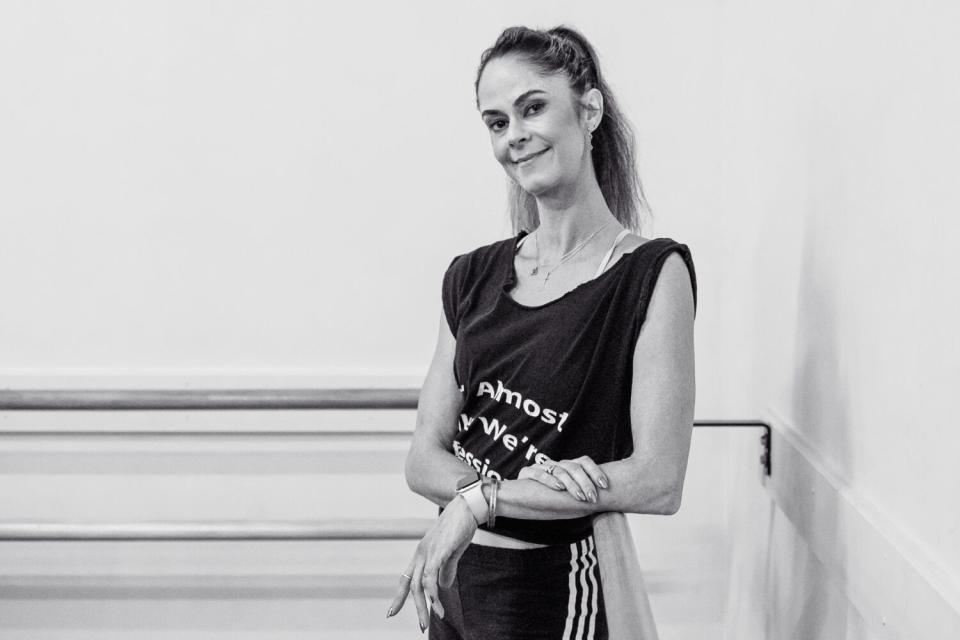How the Align Method has redefined classical ballet for Angelenos like me

At Pico and La Cienega lies a glass door. As you enter, the smell of sweat intermingles with the tittering of classical piano music. In the waiting room, a smattering of people are adorned in every manner of tights, leotards and activewear. When the studio door swings open, earnest dancers file in, taking their place at the barre and waiting patiently for their ballet class to begin.
Adult non-professional ballet has long been ignored, the public perception being that ballet classes are only reserved for children and professionals (or those aspiring to be onstage). But the Align Ballet Method gives the dancers who are neither the spotlight. This is their sanctuary and mine as well; I am also a student there. It’s a place to move, decompress and revere the more than 500-year-old art form, where most go to strengthen their well-being rather than their career.

Founded in Los Angeles in 2011 by Michael Cornell, the Align Ballet Method was born out of a desire to make ballet approachable for adults, despite whether they know a "tendu" from a "dégagé." While adult ballet has long existed, it is niche and has little marketing presence. It is often an afterthought for studios whose main focus is either children and teens, or their journey from amateur to professional. Through Cornell’s streamlined workshops, adults with zero experience are able to receive training that is not only novice-friendly, but also welcoming and precise — though it is not surprising to also share the barre with advanced dancers. With six locations, and Pico being their flagship, he believes that ballet belongs to everyone.
“I never fit into the ballet world,” says Cornell, who danced professionally at Columbus, Ohio’s BalletMet for a decade. “It was never a place I felt fully accepted because my feet were bad. I always had to hide that. I've never believed in the pretentious elements that are forced upon us, that this is what a ballet dancer should be. I've always wanted to smash that perception.”

Susan Vishmid, a professional dancer who Cornell refers to as his “secret weapon” because of her attention to detail and emphasis on flawless technique, teaches beginner, intermediate and pointe classes on Tuesday nights at the Pico location. She studied at several acclaimed companies like Pacific Northwest Ballet and San Francisco Ballet, going on to dance professionally for a number of years at the Pennsylvania Ballet. She is currently the artistic director and choreographer of the L.A.-based dance company Freaks With Lines, whose mission is “to produce work that subverts traditional norms often associated with the ballet world.” They are holding a gala performance in Pasadena on Saturday.
“I enjoy teaching adults because they're serious about learning,” Vishmid tells me. “Align focusing on adult ballet is great because people feel intimidated going to places like Westside Ballet, which is an institution and my home studio. But everybody's capable of learning ballet technique, I truly believe that. And why not? There's a momentum, a cadence to class. It's procedural and logical. There are rules. Nobody becomes an artist before they become a technician, and proper technique is the greatest equalizer.”

Thanks to the influx of social media, the heightened visibility of icons like Misty Copeland, and celebrities like Chris Pine who proudly practice ballet and praise its benefits, the field is more welcoming than ever. But ballet is historically unwelcoming, especially in terms of race, age and physique. Gelsey Kirkland, who was invited by messianic choreographer George Balanchine to join the New York City Ballet in 1968 at 15, quickly joined the annals of ballet royalty, partnering with — both on and off the dance floor — the famed Mikhail Baryshnikov. But her meteoric rise ravaged her body and mind.
“You were pushed to the limits in terms of what your body can take,” she told Diane Sawyer in 1986 during a revealing "60 Minutes" interview. In the same interview, she says that Balanchine emphasized the aesthetic importance of seeing bones through one’s skin. While she dazzled in the spotlight, the pressures of the industry hurled her into an abyss of cocaine addiction, anorexia and bulimia, she later said. At one point she weighed only 80 pounds. Disordered and restrictive eating, as well as the rail-thin ballerina archetype, are pervasive facets of ballet lore, as depicted in films such as "Center Stage," "Black Swan" and "Dying to Dance."
“Insecurity is a major impediment to almost anyone stepping into the ballet studio,” Cornell says. “It's an intimidating environment because there are all these preconceived notions. The identity of a ballerina is such an unattainable ethereal concept.”

Eventually, Cornell decided it was time for ballet to lighten up. Describing “the culture of perfectionism” as oppressive, he eventually gave up his dance career and hit the road as a stand-up comedian, which landed him in Los Angeles. After realizing that auditions and late nights at comedy clubs brought him nothing but anxiety, he changed his trajectory and got certified as a personal trainer. When one of his clients, a septuagenarian named Judith, asked him to teach her ballet, he had an idea.
“Professional ballet dancers are such highly-trained pieces of advanced machinery,” Cornell describes, “that when they teach beginning ballet, they have trouble slowing it down. Working with non-dancers gave me a huge insight. You begin with one-dimensional movement and build from there. You don't pile on a whole sequence. That's the philosophy the Align Ballet Method was built on — the idea of simplicity.”
Joanne Whalley, 61, is a UK-born actor of the stage and screen who has starred in films such as "Willow" and series such as "Daredevil." A yoga devotee since childhood, she decided to try ballet, joining Align around 2016. “Beauty is a powerful force and ballet isn’t about what’s on the surface,” Whalley shares. “The beauty’s coming from inside. I thank my lucky stars that Align exists. I can't imagine not having it in my life. It opened this door into a world I never knew. It's been an absolute life-changer and Michael is a fantastic teacher. He makes me laugh, which is a bonus, but I especially love how he can teach anyone.”

Another student, Shareen Ross, is 64 and decided to take her first ballet class at 60. She dreamed of dancing on pointe — an opportunity she thought had long since passed — and because of Align, she was able to accomplish this feat. However, when she tragically lost her husband to cancer, she found another benefit of ballet.
“Because it's a form of expression, it helped me through the grief of losing my husband in a way that nobody had to know, but I know because I'm feeling it,” she says. “At the same time it's social, forcing you out there to make new friends. Now, I feel strong — physically, emotionally — and my posture is great.”
The Align Ballet Method has created a sanctuary of art, expression and movement. It opens its doors and floors to any who are willing to sweat and stretch their bodies into unnatural, yet graceful, positions. But mostly it proves that you don’t have to fit into the young, lithe mold of a professional ballerina to feel as if you’re dancing like one.
“My deeper thought,” Cornell declares, “was to open the ballet world and make it accessible. If you want to try ballet, we're gonna accept you — your shape, size, age, skin. You can decide how fast or slow you want to go, but you’ll be supported all the way and you will not be disparaged.”

This story originally appeared in Los Angeles Times.

